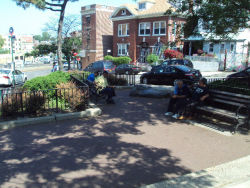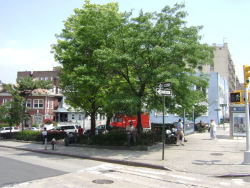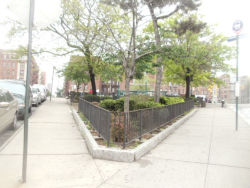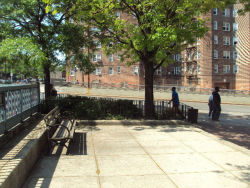Echo Triangle
Echo Triangle
This park and the adjacent Echo Place derive their name from a wooded glen, once situated on nearby Webster Avenue, which was famous for its echoes. Originally owned by James Buckhout, Echo Place was formerly known as Ludlow Street, from Concourse to Anthony Avenue, and Buckhout Street from Anthony Avenue to Julius Richman Park (formerly Echo Park). Echo Place received its current name in 1903.
Echo Triangle is formed by the intersection of Echo Place, East Tremont Avenue, Grand Boulevard, and Grand Concourse. The initial concept for the Grand Concourse came from the engineer Louis Risse in 1870, who intended a boulevard in the Continental style for horses and carriages. The distinctive characteristics of his design were its remarkable breadth of 182 feet and its usage of varying elevations, with underpasses at large intersections, that allowed for an “express” lane of uninterrupted traffic.
Eventually completed in 1909, the road ran from Mosholu Parkway down to East 161st Street. In 1927, it absorbed Mott Avenue, which ran from East 149th Street to this site on East 138th Street, making the total length of the Concourse four and a half miles. Throughout the first half of the 20th century, major government, commercial, and residential buildings were situated along the Grand Concourse.
The neighborhood of East Tremont, after which East Tremont Avenue is named, was originally known as Upper Morrisania. However when local postmaster Hiram Tarbox realized that mail posted for Morrisania was getting misdirected, he suggested the neighborhood be renamed Tremont for the three mounts in the area: Mount Hope, Mount Eden, and Fairmount.
Parks acquired Echo Triangle by condemnation on May 31, 1899. The park features World’s Fair benches, wrought iron fencing, and various types of shrubbery. The Tremont Avenue subway station is accessible from stairs on the edge of the triangle. Echo Triangle is part of the Greenstreets program, a joint effort by Parks and the New York City Department of Transportation begun in 1986 and revived in 1994. Its goal is to convert paved street properties, such as triangles and malls, into green spaces.
Check out your park's Vital Signs
Clean & Safe
Green & Resilient
Empowered & Engaged Users
Share your feedback or learn more about how this park is part of a
Vital Park System




